The human impact on climate and the Earth itself can often be seen on a massive scale. Think of the melting Arctic or check out the photographic work of Ed Burtynsky.
But Susan K. Harrison, a hospice chaplain and psychotherapist in Windsor, Ont., is doing her part to help on a much smaller and more local scale.
Through setting up patches of milkweed as monarch butterfly way-stations, she has been able to collect and preserve both monarch and swallowtail butterfly eggs. She has released 23 butterflies to date, with plans to release 30 more this year.
Harrison says that habitat loss and human activity are the biggest threats to monarchs, whose caterpillars exclusively eat milkweed, a plant that is becoming harder to find in the wild. Harrison hopes to be part of the remedy to keep the species going.
She is new to the world of rearing monarchs but has found a community of like-minded individuals in Essex County in southwestern Ontario. She has learned how to spot and care for eggs, caterpillars and butterflies through a Facebook group of local enthusiasts whose main interests are the survival and well-being of these delicate insects, and educating others.
Harrison gets to enjoy the metamorphosis of the monarch up close and personal. She even tells a story of a butterfly perching on her shoulder for hours while it prepared for its first flight. “The transformation a butterfly goes through has so much metaphorical relevance for me,” says Harrison, who also deeply cares for people as a grief-support-group facilitator.
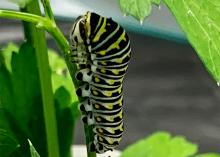
An eastern black swallowtail has just shed its skin and has moved to the next size of caterpillar. It will turn around and eat that skin before moving on to some parsley or dill. (Photo courtesy of Susan K. Harrison)

An eastern black swallowtail has just emerged from her cocoon (to her right). This was Susan K. Harrison’s first successful attempt to raise the insect from egg to butterfly. (Photo courtesy of Susan K. Harrison)
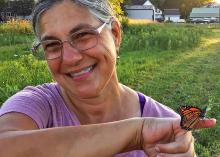
Harrison releases a monarch butterfly at a farm in LaSalle, Ont., where the owner, Dick Wood, has allowed the land to naturalize, nurturing biodiversity including monarch and swallowtail butterflies. (Photo courtesy of Susan K. Harrison)

‘The nursery’ in Harrison’s kitchen. Each cage has a test tube holder and tubes full of water that hold cuttings from milkweed that have monarch eggs or newborn caterpillars on them. The other tent has tubes of water holding cuttings of parsley with eastern black swallowtail eggs and newborn caterpillars on them. When they get old enough to pose a threat of eating the other eggs, they are moved to an outdoor cage, where they will eventually form their chrysalides. (Photo courtesy of Susan K. Harrison)
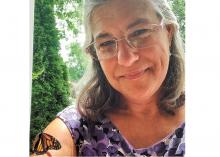
A newly released female monarch butterfly decides it is not ready to leave Harrison, so it walked up her arm and sat on her shirt for the rest of the afternoon. It flew away later that evening. (Photo courtesy of Susan K. Harrison)
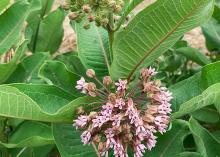
Monarch caterpillars can only eat milkweed, and they only lay their eggs on the milkweed plant. Without an available supply of milkweed, they are at risk of extinction. To Harrison, they are pretty plants that people who want to help the monarch survive can easily incorporate it into their gardens. (Photo courtesy of Susan K. Harrison)

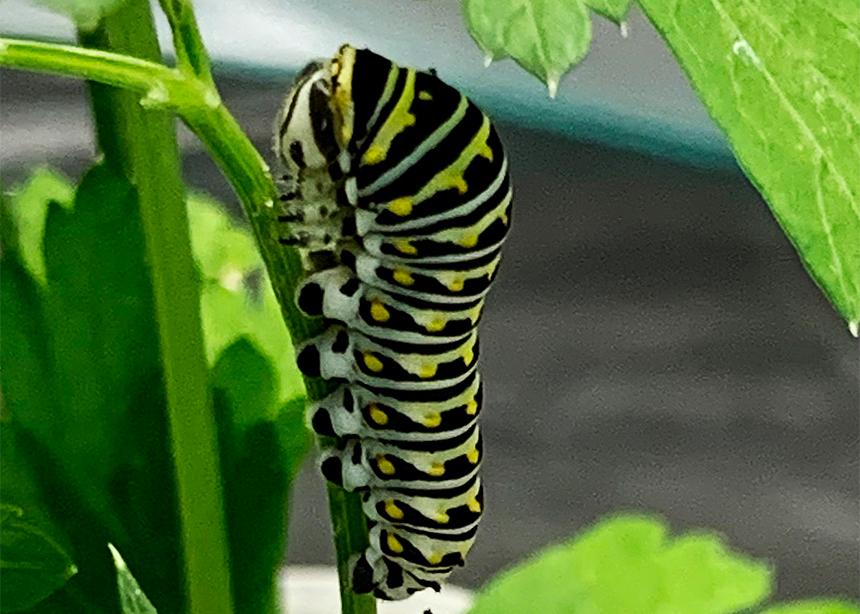

Add new comment
Canadian Mennonite invites comments and encourages constructive discussion about our content. Actual full names (first and last) are required. Comments are moderated and may be edited. They will not appear online until approved and will be posted during business hours. Some comments may be reproduced in print.